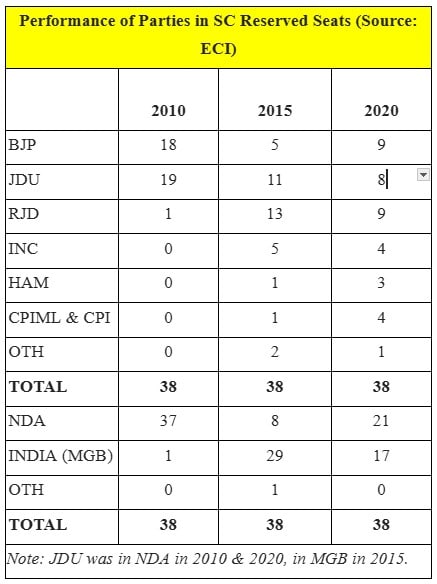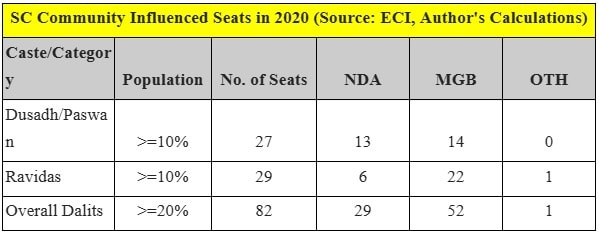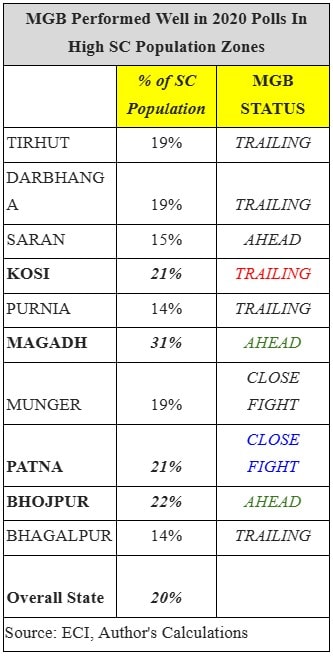As both the National Democratic Alliance (NDA) and the Mahagathbandhan grapple to finalise seat-sharing arrangements, and with the last date for nominations approaching, the political cauldron is heating up in Bihar. In the complex electoral arithmetic of the state, where caste equations often determine political outcomes, the Scheduled Caste (SC) voter could emerge as the kingmaker in these elections.
Every One In Five Voter Is SC
The recently released caste census data in 2023 has revealed a crucial dynamic that changes the political calculus of the state. Scheduled Castes account for around 20% of Bihar's population, 4 percentage points higher than the 16% share recorded in the 2011 national census. This difference translates into five to six million voters whose political significance has been underestimated for over a decade.
Within this community, three groups dominate the demographic landscape. The Ravidas community constitutes approximately 5% of the state's population, as do the Paswans, while the Musahars account for 3%. Together, these three communities represent nearly 65% of the total SC population in Bihar.
Bihar has 38 reserved seats in its 243-member legislative assembly. In 2010, the NDA achieved an overwhelming dominance, winning 37 of these 38 seats. However, by 2020, this margin had dramatically narrowed to 21-17 in favour of the NDA.
The most striking result came in 2015, when the Janata Dal (United) (JD-U) fought alongside the Mahagathbandhan; the alliance swept these reserved seats comprehensively, 29-8. In terms of individual strength, the Bharatiya Janata Party (BJP) and the Rashtriya Janata Dak won nine seats each in 2020, followed by the JD(U) and the Congress-CPI(ML)-CPI combine, with eight seats each.

The Paradox Of Reserved Seats
There exists a common misconception about SC voters, that their influence is primarily restricted to reserved constituencies. The reality is quite the opposite. In reserved seats, since all major parties field SC candidates, the community's vote is divided, which means the decisive factor often are the non-SC caste blocks.
Paradoxically, SC voters have limited influence in determining outcomes in constituencies reserved for them. The true political power of SC voters manifests in non-reserved constituencies. In these seats, the SC vote can swing results decisively in favour of one alliance or another. This is where the community's 20% population share becomes a game-changing factor.
The electoral map demonstrates this influence clearly.
- In constituencies where Paswans comprise more than 10% of the population - 27 seats in total - the MGB won 14 seats, while the NDA bagged 13 in 2020
- For Ravidas-dominated areas with more than 10% population share, there are 29 such seats, with the MGB winning 22 and the NDA just six.
- Most significantly, in 82 constituencies where the overall SC population exceeds 20%, the MGB led in 52 seats compared to the NDA's 29.

Who Votes For Whom
The 2020 election results offer additional insights into voting patterns. Approximately 40% of SC voters backed the NDA, 25% supported the MGB, and a substantial 35% voted for others, primarily because the Lok Janshakti Party (LJP) contested separately, splitting the traditional NDA vote base, per a Centre for the Study of Developing Societies (CSDS) post-poll study. The LJP bagged 32% of Paswan community votes.
The political preferences of different SC sub-communities are heavily influenced by their leadership. The Ravidas community has traditionally aligned with parties like the Bahujan Samaj Party (BSP) on Bihar's eastern border with Uttar Pradesh and the Congress. To cement this support, the Congress party has appointed Rajesh Ram as its state president.
Meanwhile, Paswan and Musahar voters have gravitated toward the NDA, largely due to the leadership of Chirag Paswan of the LJP and Jitan Ram Manjhi, who represents Mahadalit interests within the NDA framework.
An analysis of administrative zones where SC population exceeds the state average of 20% underlines the community's decisive role. Of four such zones, the MGB led in two in 2020 (Magadh and Munger), the NDA in one (Kosi), and one - Patna - exhibited a close contest. The performance in heavy SC population zones gave a boost to the MGB, which gave a spirited fight to NDA, losing by just 12,000 votes.

The Shift in 2024
The 2024 general elections marked a significant shift in SC voting patterns. The MGB gained an estimated 18-20 percentage-point votes among SC voters, primarily on the strength of the "samvidhan khatre mein hai" (the Constitution is in danger) narrative. Approximately 60% backed the NDA and 40% SC voters backed the Mahagathbandhan (or INDIA) bloc.
The alliance successfully framed the election around concerns that the Constitution would be changed and reservation policies would be under threat if the BJP crossed 400 seats - something that resonated deeply with SC voters.
Building on this momentum, the MGB has launched initiatives like the "Voter Adhikar Yatra" in this election and raised allegations of vote manipulation and mass deletions of marginalised communities in the SIR (Special Intensive Revision) process, attempting to further cement SC support.
Why Welfare Schemes Work
The socio-economic profile of Bihar's SC community reveals deep-rooted disadvantages that make them particularly responsive to welfare schemes and direct cash transfers. According to caste census data, 43% of SC households have a monthly income below ₹6,000, compared to the state average of 34%. A staggering 72% earn less than ₹10,000 monthly, against the state average of 65%.
Educational indicators are equally concerning. Only 3.14% of SC individuals are graduates, compared to the state average of 6.47%. The illiteracy rate stands at 41%, much higher than the 31% statewide rate. Employment in government jobs, despite 16% reservation, is just 1.13% compared to 1.57% overall, while private sector employment is merely 0.51%.
These stark economic realities explain why welfare schemes, freebies, and cash transfers work particularly well in SC-dominated constituencies. For communities struggling with basic survival, immediate economic relief often trumps long-term political considerations. This is what the NDA is harping on by announcing schemes for all four key segments, namely, the youth, farmers, senior citizens, and labour.
The Kingmakers
Despite political reservation, SC communities in Bihar have weak bargaining power. They rarely occupy key positions in government or hold significant ministerial portfolios. This representation without real power diminishes their ability to influence policy decisions that directly affect their lives.
The community is not monolithic, and internal divisions between groups like Ravidas and Paswan, or the broader Dalit and Mahadalit categorisation, further weaken their collective bargaining power. Political parties have historically exploited these divisions, offering symbolic representation to different sub-groups while avoiding substantive power-sharing.
For political parties seeking to consolidate SC support, mere symbolism will no longer suffice as awareness levels increase. What is needed is genuine representation in decision-making positions, dedicated manifesto commitments addressing community-specific concerns, and concrete action on employment, education, and economic empowerment.
As Bihar approaches its next electoral test, the SC vote remains the deciding factor. With 20% of the population and concentrated influence in over 80 constituencies, this community holds the key to power. Whichever alliance successfully addresses their aspirations - both symbolically and substantively - will likely form the next government in Patna.
The question is no longer whether the SC vote matters, but rather which political formation will earn their trust and, with it, the right to govern Bihar.
(Amitabh Tiwari is a political strategist and commentator. In his earlier avatar, he was a corporate and investment banker.)
Disclaimer: These are the personal opinions of the author



